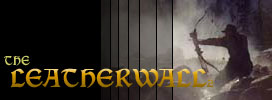Thanks to everybody,you're very kind. My synthetic Sipahi'Golhan bows' are very short,N x N 113cm(44,49''),it's very fast and very good for expecially mounted archery. Yes,you're right about the 'Kangaroo' leather,i had heard it's power,but had not heard the 'roo' leather. Ottoman Bowyer's 'choice' was the 'Horses Skin(Sagri)'.It's very hard and tight material.But i think,other hard and tight leathers can be use for this purpose. Main purpose is streching the leather like a sinew.And Now,
By applying 0.5mm thick(0,0197 inc) goat skin onto the back of the bow with an incremental weight increase of 16.6 grams an incremental draw-weight increase of 1.5-2 lb, and an increase of 4-5 fps in arrow speed were achieved.
PRE-STRESSED LEATHER APPLICATION METHOD (GOLHAN METHOD) No.1 1)Pre-stressing the leather before backing and applying leather while the bow is unstrung. The incremental power addition with this method is related to the quality, type, elasticity, thickness of the leather used, and the degree of pre-stressing. In addition, the effect of chemicals used in this process cannot be undermined. 0,5mm thick goat skin was used for this ‘backing’ process. This type of skin will give some indication of the incremental power pre-stressed leather would add (I will be using horse skin in the next application). And, I am sure, comparison of these two applications will shed light on the Ottoman Bowyer’s “choice” of the horse’s skin (sagri).
Before backing the bow with suitable leather (Organic, or synthetic bow will not matter), The draw-weight of the naked bow is to be measured with the dynamometer (draw-weight measurement device) to be able to compare weights before and after.
Procedure:
A) Measurement of the draw-weight by a dynamometer, Naked bow pulls : 50 lb. B) Measurement of the weight of the naked bow on a digital scale, Naked bow weighs: 324,6 gr
Now we can go ahead with the application; After firmly fixing the bow on the workbench the skin is glued onto the outside of the grip (only) from one end to the other end. This area will give us the fixing point/starting point of the stretch.
Next, is the ”Sal” zone. This zone is where the skin will be performing just like the sinew. While stretching the skin gently mark “point 0” on the inside of the skin at 1cm before the Kasan head ( the incremental power will vary depending on this distance). ******Resim****** The stretching of the skin from “point zero” to the kasan head and fixing with glue:
The back of the bow till the Kasan head and corresponding area of the skin till the “point 0” are coated with rubber based adhesive and let to dry 10-15 minutes. Then, with the bash pressed against your tummy stick the skin on while stretching “point 0” up to the kasan head. Press this point first and then stick the sal area by stretching it perpendicularly as well as vertical. Repeat the same procedure for sticking the skin on to the kasan area (kasan head till kasan end). By this way, the very important task of “pre-stressing” the skin on the “sal” area is accomplished.
Following this, the skin is glued to the rest of the bow and necessary finishing is done.
Next stage is the “Application of Chemicals”.
As I have mentioned before , the chemicals issue is open to improvements as this application has a “great” impact on the strength of the leather. With the application of the solution, the leather becomes harder and tensile strength improves. At this stage the only chemical I use is a mixture of shellac and spirit(ethyl alcohol). This mixture must be applied with a brush or cloth in sufficient amounts making sure that it is absorbed as much as possible. I usually apply three coats and this gives the leather a glossy look. One can achieve various colors by adding some natural dry pigment. After this application the skin becomes glossy and tough. With the application of the chemical the procedure is completed. But, one should not hurry to measure the draw-weight. We need to wait for two days so that the adhesive is also hardened. This adhesive behaves similarly to the chemicals. And, the bow created looks like the one below.
Pre-stressed (Golhan method) leather applied Sipahi Bow Two days later, the bow is stringed and draw-weight at 28” is measured by a dynamometer, and bow is weighed once again on a digital scale.
The new draw-weight: 51.5- 52 lbs. (incremental improvement 1.5-2 lbs). The new bow weight: 341.2 gr Skin thickness: 0.5 mm Leather+Chemicals+decorative painting weight: 16,60 gr
Conclusion:
By applying 0.5mm thick goat skin onto the back of the bow with an incremental weight increase of 16.6 grams an incremental draw- weight increase of 1.5-2 lb, and an increase of 4-5 fps in arrow speed were achieved.
However, the best result out of the Golhan method is;
The leather backing that was thought to be a “backing , and a protective layer from moisture for many authorities actually was proven to increase the draw-weight, and arrow speed by working the same way as the sinew. You can read the texts and see all of description pictures on my site clearly.(http://www.ottomanturkishbows.com/)
Thanks, Mehmet Golhan




